[FIELDWORK] Still Human, Oliver Chan (2019)
Oi-Man Estate, Ho Man Tin, Hong Kong
Directed by Oliver Chan, Still Human was released in April 2019. Portraying a genuine relationship happening in Oi-Man Estate between two socially-ostracized dwellers Cheong-wing, a disabled man who lost enthusiasm in life, and Evelyn, a Filipino who came Hong Kong working as a domestic helper to pursue her goals in life, the film hints at multiple Hong Kong social issues. To Evelyn, Oi-Man Estate has transcended to a space from a place as her bonding with Cheong-wing strengthens.
The film begins with Cheong-wing maneuvered in his wheelchair in a customized and limited space, suggesting the typical look of the interior setting of a small public house unit. The camera then zooms out, introducing the first encounter of the protagonists and an overview of Oi-Man Estate, which plays a significant role in the film due to its design and symbolism.
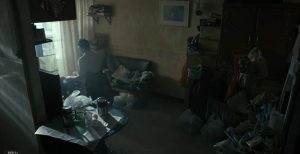
Oi-Man Estate replicates the reality almost identically. Instead of manipulating the setting into a fictional space, the film documents the place while narrating the story. The place in real life is tranquil yet vivid, just like the relationship between Cheong-wing and Evelyn, nothing rapid happens in this residential area but stories continue constantly. Stories are told parallelly; dwellers coincide without knowing one another here. In the film, Oi-Man Estate contextualizes Cheong-wing’s challenged living environment and provides a place for the story to take place. Public housing is often associated to the underprivileged for example financially-challenged citizens and minorities. Setting the film there reinforces the miserable live Cheong-wing is living. Through a series of ordinary events, these two unfortunate ordinary strangers develop extraordinary trust and bonding. This resonates with the humble yet colorful nature of the estate.
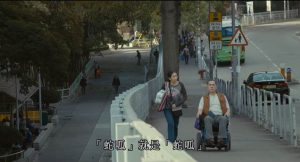
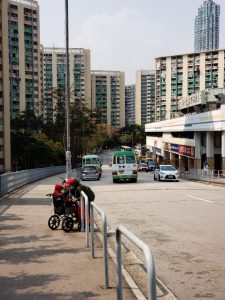
Another story to be hold!
Look-wise, the film restores every element, from the infrastructure (the slope) to the façade of the buildings; from the bus stop to the entrance of Sun-Man House, as the estate has not undergone any major change since the production of the film. However, to dramatize the viewing experience, colors are intensified and harmonized for aesthetic purpose and to build a more harmonious atmosphere. Not only does it not diminish the aura of the space but amply it by visualize the intangible quality of it – the ambience by colors.
The film does not merely tell the story between two people but brings light to difficulties faced by the underprivileged and encourages viewers to pursue their dreams. These messages are allegorized by spaces in the “town”.
The protagonists appear travelling on the slope multiple times. Dwellers must pass this piece of infrastructure, which connects the estate to the surrounding facilities like the market and the bus stop. The inclined slope symbolizes the inevitable difficulties faced by the underprivileged.
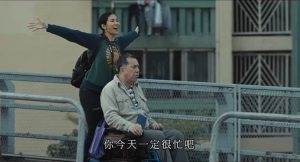
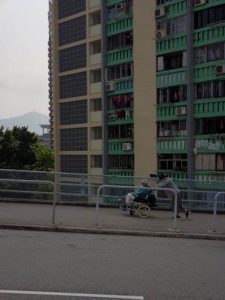
Communication barrier is symbolized by the entrance of Sun-Man House. Not understanding Cantonese, Evelyn, who is new to Hong Kong, cannot communicate with Cheong-wing nor access into the house, which also represents the local community, through the gate.
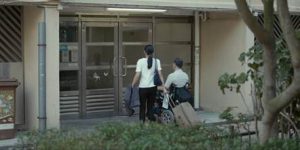

Ambiance of the lightwell in San-Man House suggests freedom and dream. Confined by four walls, Evelyn holds her camera up to the opening in a gloomy setting. Despite being an underdog, Evelyn still holds on to her dream and see hope, suggested by the light casting into the middle from the opening. Cheong-wing tries to commit suicide by climbing over the fences yet fail. The fences confine Cheong-wing as if cages, restraining him freeing from the sufferring and the wheelchair.
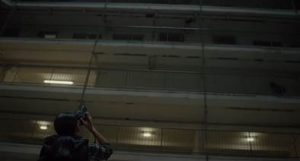
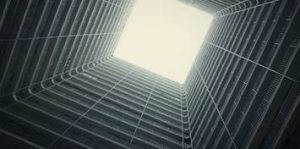
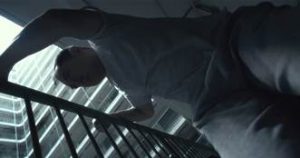


-Bosco Yeung Ho Lam 3035794210
Films can be read in many ways because there are usually quite a number of symbolisms presented, and you pointed out the key aspects thoroughly. As you mentioned, a simple bannister could be perceived as a different thing for different people. The slope, the gate, the bannister, and maybe even the room – the mundane spaces – are representing something else in the film. How would you conclude your observation and main argument here? Would it be related mainly to De Certeau’s “space as practices place”? Or, what about space’s aura that is so compelling? In what way has the aura been built throughout the film? You also mentioned the contrasts that have been exposed in the film. Elaborating on this aspect could help you to enhance your statements more, too. Also, remember to put a proper reference to your writing. All cited text and images which are not yours must be referred correctly to the original sources.